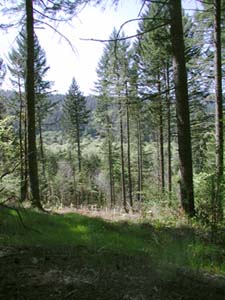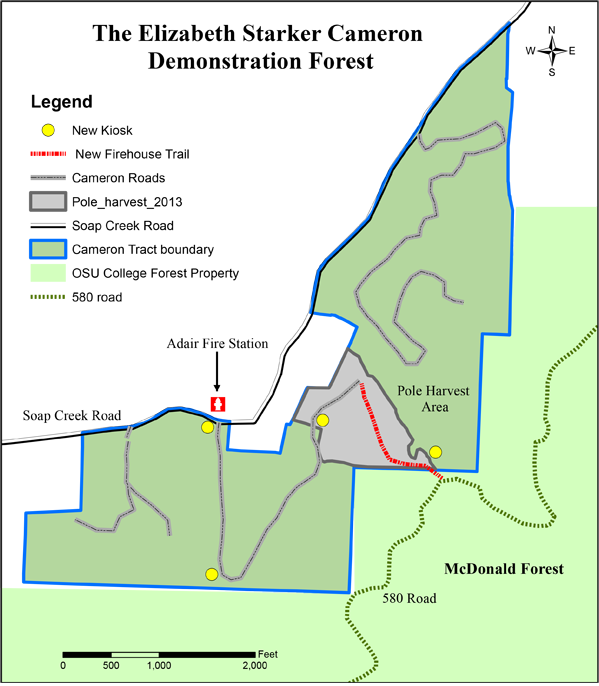This 260-acre property was given to the Oregon State University College of Forestry in 1995 by Elizabeth Starker Cameron. The Tract is managed for three purposes:
- To demonstrate good private forest stewardship
- To experiment with management alternatives for private forest owners
- To provide income from periodic timber harvests to support a continuing program in private and family forestry at OSU
You are welcome to visit the Cameron Tract, but please remember to follow these simple rules:
- Horses and bikes allowed on roads only!
- No motorized vehicles
- No hunting
- No fires
- No camping!

Forest Mission
The Elizabeth Starker Cameron Demonstration Forest is owned by the Oregon State Board of Higher Education and managed by the OSU College of Forestry for the purpose of developing and demonstrating innovative forest stewardship practices with application for family-owned forests. The Tract's mission is distinguished from that of other College forests by its focus on forest management for family-owned forests.
Vision and Guiding Principles
The Elizabeth Starker Cameron Demonstration Forest is a model of family forest resource stewardship, a source of information and inspiration for family forest owners, a resource in support of the College of Forestry's Program in Private and Family Forestry, and a good neighbor valued by Soap Creek residents. In order to achieve this vision, the Cameron Tract is managed in accordance with the following guiding principles:

- Stewardship: As a model of family forest stewardship, the Tract is actively managed to produce a sustainable flow of ecological, economic, and social values and services.
- Education and Demonstration: Tract activities are designed to demonstrate innovative, cost effective forest resource planning and management practices relevant to family forest ownerships.
- Participation: Opportunities are created for meaningful participation by family forest owners and others in planning, management, and educational activities on the Tract.
- Good Neighbor: The Tract is managed so as to develop and maintain relationships of trust, open and honest communication, and mutual learning between those who manage, use, and reside near the Tract.
Long Term Goals
Long term goals for the Cameron Tract, consistent with the intent of the donor and the purposes of the College of Forestry, are as follows:

- To sustain and enhance the physical, biological, and social resources associated with the Tract. It is the intent of the College of Forestry that it manage the Tract in perpetuity. A sustainable flow of forest products and amenities is to be maintained.
- To demonstrate good family forest stewardship through active management of the Tract's forest and related resources. The Tract will be managed to sustain and enhance existing resources while producing multiple products and values. Stewardship will be demonstrated through the selection of management activities and the care with which they are designed and undertaken. Demonstrations and other educational events will be conducted in association with management activities, and as special opportunities arise. Management operations will be designed and scheduled so as to maximize education and demonstration value while being cost-effective and responsive to changing timber market conditions. Family forest owners will be the primary, but not sole, audience for Tract demonstrations. Educational events may also be designed for neighbors, policy makers, foresters, students, and other audiences.
- To experiment with innovative forest management practices and strategies appropriate for adoption by family forest owners. Potential practices include but are not limited to management planning, effective site preparation, reforestation, and young stand management activities; innovative silvicultural systems, timber harvest designs, and harvesting systems; production of non-timber forest products; forest monitoring; multiple use management; forest road design; and management of aesthetic, unique or rare resources. Recreational uses compatible with the Tract mission are permitted and accommodated where feasible.
- To generate periodic income to be used to support the College of Forestry's Starker Program in Private and Family Forestry. Revenue from periodic timber sales is anticipated to be the primary source of income, but sales of non-timber forest products, and other income-generating activities are not precluded.
- To nurture a longterm, collaborative, mutual learning relationship between the College of Forestry, family forest owners, and others who care about family forests in Oregon. The Tract is to be seen as an arena where forest owners, foresters, neighbors, and others, can learn together and from each other. It is to be valued as a good neighbor in the Soap Creek neighborhood. The affairs of the Tract shall be managed in such a manner as to foster an environment of mutual respect, open communication, and neighborliness. These general goals will guide management of the Tract. Planning for major management activities such as timber harvests or road construction will take place within the framework of this longrange plan, and on a five to ten year basis. Planning for specific management, demonstration, and education activities will take place throughout the year as opportunities and needs arise.
Organizational Structure and Decision Process
The Starker Chair in Private and Family Forestry leads development and management of the Cameron Tract in close collaboration with the Cameron Tract Advisory Board, OSU College Forests staff, and OSU faculty. The responsibilities of each of these partners is outlined below:
1. The Starker Chair in Private and Family Forestry provides leadership for all activities involving the Cameron Tract, including planning, natural resource management, timber harvesting, research, teaching, demonstration and extension education. The Starker Chair has overall responsibility for management of the Tract, in consultation with the Director of College Forests and with approval of the Dean of the College of Forestry.
2. As needed, a Cameron Tract Advisory Board is convened to provide input and advice to the Starker Chair on Tract planning, policies, management, and educational activities. The Board comprises representatives from the following:
- OSU College Forests,
- OSU extension, research and teaching faculty,
- Oregon family forest owners,
- Soap Creek neighborhood,
- Other individuals with relevant expertise and approval of the Starker Chair.
3. College Forest staff provides expertise and assistance in planning, engineering, management, timber harvesting, contracting, facilities, and other areas within their normal purview. Arrangements with private contractors may also be made to accomplish project objectives.
4. OSU extension faculty provide leadership, educational expertise, and logistical support for demonstration and extension education activities on the Tract. Research and teaching faculty are encouraged to utilize the Cameron Tract for purposes congruent with its mission, and with approval of the Starker Chair.
This document updated May, 2012.

